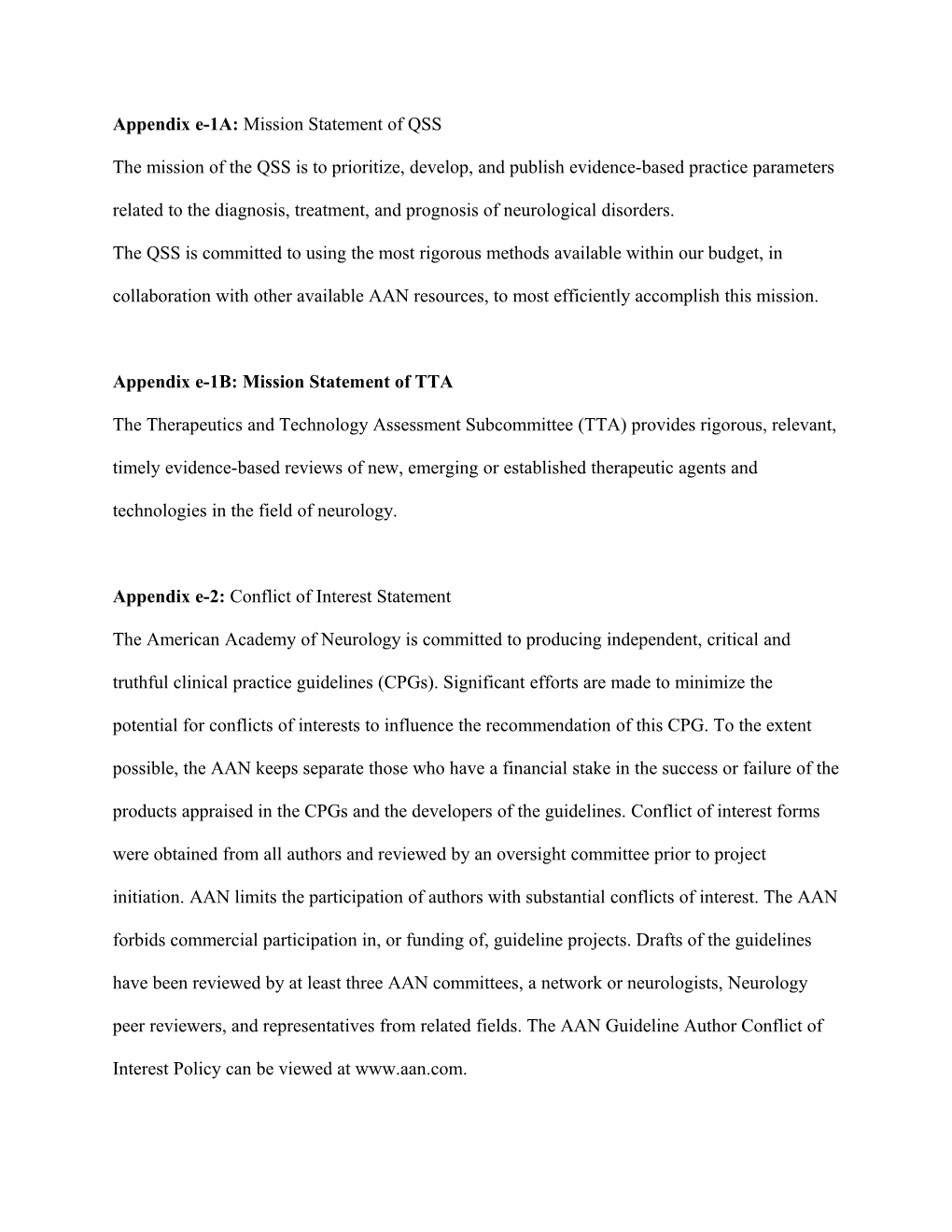Appendix e-1A:Mission Statement of QSS
The mission of the QSS is to prioritize, develop, and publish evidence-based practice parameters related to the diagnosis, treatment, and prognosis of neurological disorders.
The QSS is committed to using the most rigorous methods available within our budget, in collaboration with other available AAN resources, to most efficiently accomplish this mission.
Appendix e-1B:Mission Statement of TTA
The Therapeutics and Technology Assessment Subcommittee (TTA) provides rigorous, relevant, timely evidence-based reviews of new, emerging or established therapeutic agents and technologies in the field of neurology.
Appendix e-2:Conflictof Interest Statement
The American Academy of Neurology is committed to producing independent, critical and truthful clinical practice guidelines (CPGs). Significant efforts are made to minimize the potential for conflicts of interests to influence the recommendation of this CPG. To the extent possible, the AAN keeps separate those who have a financial stake in the success or failure of the products appraised in the CPGs and the developers of the guidelines. Conflict of interest forms were obtained from all authors and reviewed by an oversight committee prior to project initiation. AAN limits the participation of authors with substantial conflicts of interest. The AAN forbids commercial participation in, or funding of, guideline projects. Drafts of the guidelines have been reviewed by at least three AAN committees, a network or neurologists, Neurology peer reviewers, and representatives from related fields. The AAN Guideline Author Conflict of Interest Policy can be viewed at
Appendixe-3A: Quality Standards Subcommittee (QSS) Members
Jacqueline French, MD, FAAN (Chair); Charles E. Argoff, MD; Eric Ashman, MD; Stephen Ashwal, MD, FAAN (Ex-Officio); Christopher Bever, Jr., MD, MBA, FAAN; John D. England, MD, FAAN; Gary M. Franklin, MD, MPH, FAAN (Ex-Officio); Deborah Hirtz, MD, FAAN (Ex-Officio); Robert G. Holloway, MD, MPH, FAAN; Donald J. Iverson, MD, FAAN; Steven R. Messé, MD; Leslie A. Morrison, MD; Pushpa Narayanaswami, MD, MBBS;James C. Stevens, MD, FAAN (Ex-Officio); David J. Thurman, MD, MPH; (Ex-Officio); Dean M. Wingerchuk, MD, MSc, FRCP(C); Theresa A. Zesiewicz, MD, FAAN.
Appendix e-3B: Therapeutics and Technology Assessment Subcommittee Members
Janis M. Miyasaki, MD, MEd, FAAN (Co-Chair); Yuen T. So, MD, PhD (Co-Chair); Richard M. Camicioli, MD; Vinay Chaudhry, MD, FAAN; Richard M. Dubinsky, MD, MPH, FAAN; Cynthia L. Harden, MD; Cheryl Jaigobin, MD; Irene L. Katzan, MD; Barbara S. Koppel, MD, FAAN; James C. Stevens, MD, FAAN (Ex-Officio); William H. Theodore, MD, FAAN.
Appendix e-4A: Classification of evidence for rating of a prognostic article
Class I: A cohort study of a broad spectrum of persons at risk for developing the outcome (e.g. target disease, work status). The outcome is defined by an acceptable reference standard for case definition. The outcome is objective or measured by an observer who is masked to the presence of the risk factor. Study results allow calculation of measures of prognostic accuracy.
Class II: A case control study of a broad spectrum of persons with the condition compared to a broad spectrum of controls or a cohort study of a broad spectrum of persons at risk for the outcome (e.g. target disease, work status) where the data was collected retrospectively. The outcome is defined by an acceptable reference standard for case definition. The outcome is objective or measured by an observer who is masked to the presence of the risk factor. Study results allow calculation of measures of prognostic accuracy.
Class III: A case control study or a cohort study where either the persons with the condition or the controls are of a narrow spectrum where the data was collected retrospectively. The outcome is defined by an acceptable reference standard for case definition. The outcome is objective or measured by an observer who did not determine the presence of the risk factor. Study results allow calculation of measures of a prognostic accuracy.
Class IV: Studies not meeting Class I, II or III criteria including consensus, expert opinion or a case report.
Appendixe-4B: Classification of evidence for rating of a screening article
Class I: A statistical, population-based sample of patients studied at a uniform point in time (usually early) during the course of the condition. All patients undergo the intervention of interest. The outcome, if not objective, is determined in an evaluation that is masked to the patients’ clinical presentations.
Class II: A statistical, non-referral-clinic-based sample of patients studied at a uniform point in time (usually early) during the course of the condition. Most patients undergo the intervention of interest. The outcome, if not objective, is determined in an evaluation that is masked to the patients’ clinical presentations.
Class III: A sample of patients studied during the course of the condition. Some patients undergo the intervention of interest. The outcome, if not objective, is determined in an evaluation by someone other than the treating physician.
Class IV: Studies not meeting Class I, II or III criteria including consensus, expert opinion or a case report.
Appendix e-5: Classification of Recommendations
A = Established as effective, ineffective or harmful (or established as useful/predictive or not useful/predictive) for the given condition in the specified population. (Level A rating requires at least two consistent Class I studies.)*
B = Probably effective, ineffective or harmful (or probably useful/predictive or not useful/predictive) for the given condition in the specified population. (Level B rating requires at least one Class I study or two consistent Class II studies.)
C = Possibly effective, ineffective or harmful (or possibly useful/predictive or not useful/predictive) for the given condition in the specified population. (Level C rating requires at least one Class II study or two consistent Class III studies.)
U = Data inadequate or conflicting; given current knowledge, treatment (test, predictor) is unproven.
*In exceptional cases, one convincing Class I study may suffice for an “A” recommendation if 1) all criteria are met, 2) the magnitude of effect is large (relative rate improved outcome > 5 and the lower limit of the confidence interval is > 2).
